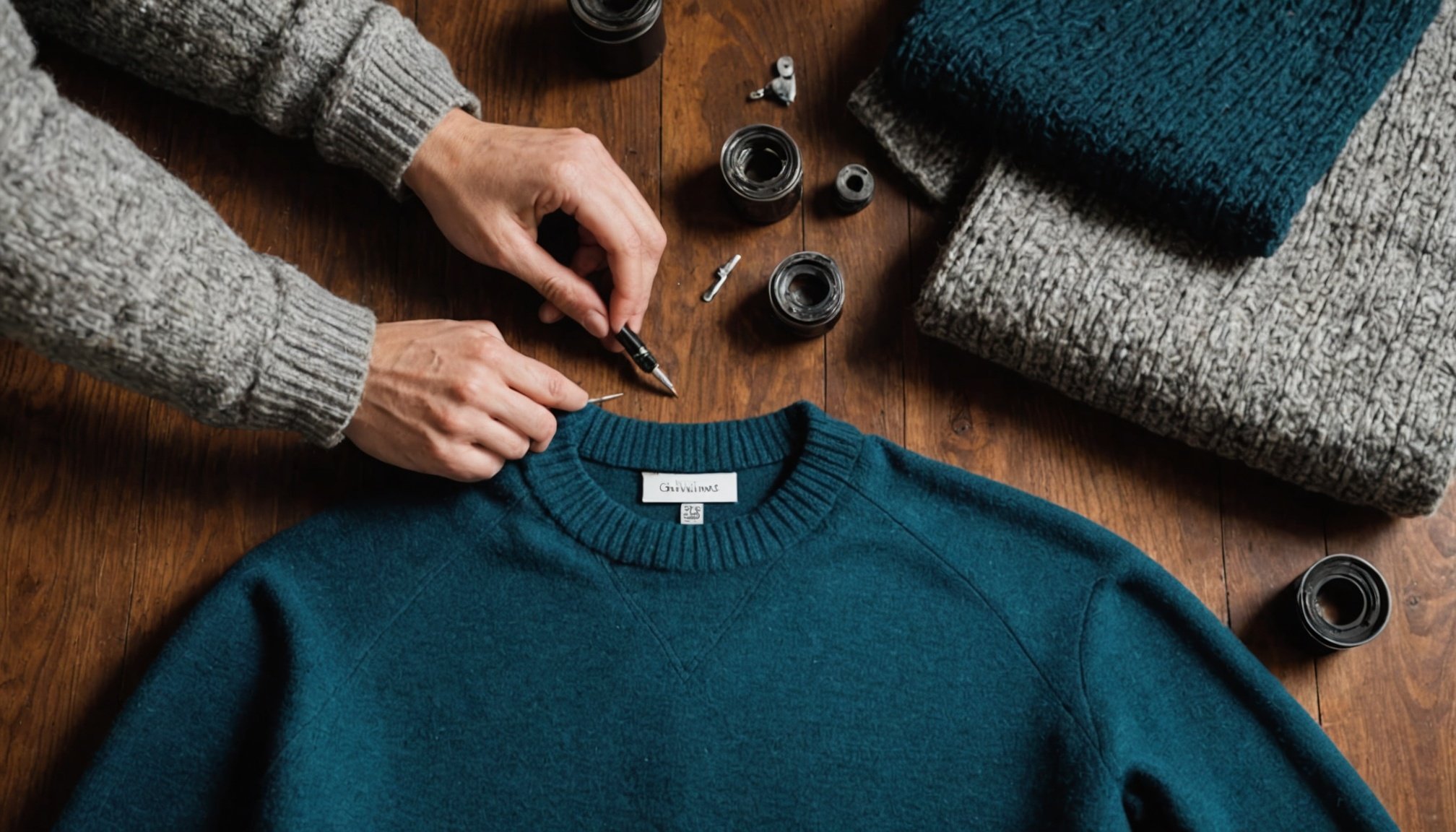Ultimate Guide to Banish Pilling from Your Merino Wool Sweaters: Proven Techniques for a Flawless Finish
Understanding Pilling in Merino Wool Sweaters
Pilling, those annoying little balls of fiber that form on the surface of your sweater, can be a significant issue for anyone who loves their merino wool garments. But before we dive into the solutions, it’s essential to understand why pilling happens in the first place.
Pilling is often a result of friction and wear. When fibers rub against each other or against other surfaces, they can break and then re-clump into those unsightly pills. Merino wool, despite its many excellent properties such as moisture wicking, warmth, and softness, is not entirely immune to pilling. However, with the right care and techniques, you can significantly reduce or even eliminate pilling from your merino wool sweaters.
Have you seen this : Sustainable laundry strategies for gently caring for your delicate uk-made fabrics
Choosing the Right Merino Wool Sweater
Not all merino wool sweaters are created equal. The quality of the fabric, the weave, and the manufacturing process can all impact how prone your sweater is to pilling.
Look for High-Quality Fabric
When selecting a merino wool sweater, look for brands that use high-quality merino wool fibers. Brands like Arc’teryx, known for their outdoor gear, often use premium merino wool that is less likely to pill.
Also to discover : Unveil london’s hidden gems: the ultimate guide to luxe artisan perfumeries
Check the Weave
The weave of the fabric can also play a role. A tighter weave generally reduces the likelihood of pilling because the fibers are less likely to rub against each other. However, this can sometimes come at the cost of breathability and flexibility.
Consider the Blend
Some merino wool sweaters are blended with other fibers like nylon or polyester to enhance durability. While these blends can be more resistant to pilling, they may not offer the same level of warmth and softness as pure merino wool.
Washing Your Merino Wool Sweater: Best Practices
Washing your merino wool sweater is a delicate process that requires careful attention to detail to prevent pilling.
Use Cold Water
Heat is a major enemy of merino wool. Washing your sweater in hot water can cause the fibers to shrink, felt, and pill. Always use cold water to wash your merino wool sweaters[5].
Hand Wash or Gentle Cycle
Hand washing is the safest way to clean your merino wool sweater. If you must use a washing machine, opt for a gentle cycle with low or no spin. This reduces the mechanical wear on the fibers that can lead to pilling[2].
Special Detergent
Use a detergent specifically designed for washing wool. These detergents are gentle on the fibers and do not contain additives that can damage the fabric. Avoid using fabric softener as it can damage the fibers and reduce the natural moisture-wicking properties of the wool[2].
Drying Your Merino Wool Sweater
Drying your sweater is just as crucial as washing it when it comes to preventing pilling.
Avoid Tumble Drying
Tumble drying is a surefire way to pill your merino wool sweater. The heat and agitation can cause the fibers to break and clump together. Instead, lay your sweater flat on a towel and gently press out excess water without wringing it. Allow it to air dry away from direct sunlight[2].
Dry Flat
Hanging your sweater to dry can cause it to lose its shape and stretch out. Laying it flat ensures that it retains its original fit and texture. If your sweater is very wrinkled, you can gently steam it, but this is usually unnecessary[2].
Preventing Pilling: Additional Tips
Here are some additional tips to help you prevent pilling and keep your merino wool sweater looking its best:
- Use a Mesh Laundry Bag: When washing your sweater, use a mesh laundry bag to protect it from friction with other clothes. This can significantly reduce the risk of pilling[3].
- Brush Your Sweater: Regularly brushing your sweater with a clothing brush can help remove dirt and prevent fibers from matting together.
- Air Your Sweater: Merino wool is naturally self-cleaning and can often be freshened up simply by airing it out. This saves water and prevents the fibers from wearing out[2].
Comparing Care Instructions for Different Types of Sweaters
Here’s a comparative table to help you understand the different care requirements for various types of sweaters:
| Type of Sweater | How Often to Wash | Washing Method | Drying Method | Special Instructions |
|---|---|---|---|---|
| Merino Wool | 3-4 times | Cold water, hand wash or gentle cycle | Lay flat, air dry | Use wool detergent, avoid fabric softener, do not tumble dry[2][4][5] |
| Cashmere | 2-3 times | Cold water, hand wash or gentle cycle | Lay flat, air dry | Use delicate detergent, avoid wringing, do not hang to dry[4] |
| Cotton | After each wear | Warm water, machine wash | Tumble dry or air dry | Use regular detergent, can be machine dried but may lose shape[4] |
| Synthetic Fiber | 4-5 times | Warm water, machine wash | Tumble dry or air dry | Can be machine dried, but may trap odors more quickly[4] |
Practical Insights and Actionable Advice
Here are some practical insights and actionable advice to help you keep your merino wool sweaters in top condition:
- Wear Your Sweater Wisely: If you’re going to be engaging in activities that cause heavy sweating or exposure to dirt, consider wearing a base layer underneath your sweater to absorb moisture and protect the fabric.
- Store Your Sweater Properly: Fold your sweater and store it lying down to prevent it from elongating. You can also use natural pest repellents like lavender or cedar to protect against clothes moths[2].
- Repair Instead of Replace: If your sweater develops a small tear or loses a stitch, repair it instead of buying a new one. This not only saves money but also reduces waste and supports sustainable fashion.
Quotes from Experts
- “Merino wool is a miracle fabric due to its natural properties, including stretch, warmth, water absorption, flame retardance, and the ability to wick away body moisture,” says a textile expert, highlighting the unique benefits of merino wool[1].
- “The key to preventing pilling is to handle your merino wool sweater with care. Avoid using hot water, fabric softener, and tumble drying,” advises a care specialist from Care of Carl[2].
Keeping your merino wool sweater free from pilling requires a combination of proper care, the right washing techniques, and a bit of patience. By following these proven techniques, you can enjoy your merino wool sweaters for a long time, appreciating their warmth, softness, and moisture-wicking properties.
Here is a detailed bullet point list summarizing the key steps to banish pilling from your merino wool sweaters:
- Wash in Cold Water: Use cold water to prevent fibers from shrinking and pilling.
- Hand Wash or Gentle Cycle: Opt for hand washing or a gentle machine cycle to reduce mechanical wear.
- Use Special Detergent: Use a detergent specifically designed for wool to protect the fibers.
- Avoid Fabric Softener: Fabric softener can damage the fibers and reduce their natural properties.
- Dry Flat: Lay your sweater flat to dry, avoiding direct sunlight and heat.
- Use a Mesh Laundry Bag: Protect your sweater from friction during washing.
- Brush Your Sweater: Regularly brush your sweater to remove dirt and prevent matting.
- Air Your Sweater: Freshen up your sweater by airing it out instead of washing it frequently.
- Store Properly: Fold and store your sweater lying down to maintain its shape.
- Repair Instead of Replace: Repair small damages to extend the life of your sweater.
By adhering to these guidelines, you can ensure your merino wool sweaters remain in excellent condition, providing you with warmth, comfort, and a flawless finish for a long time.











